Team Project Management
VerifiedAdded on 2019/11/19
|8
|1846
|149
Report
AI Summary
The assignment content is about creating a software system that will be used by the University for a long period of time before upgrading. The team values are cooperation and collaboration, effective communication, good time management, accountability, procedure and process follow-up, honesty and openness, and code of ethics. The learning cycles include ideation, elaboration, planning, execution, implementation, and control and monitoring. The activity incharge is the project manager, web developer, expert leader, IT supporter, users, executive sponsor, and stakeholders. The communication plan includes objectives, audience, information, method, frequency, and purpose. The reflection part highlights the importance of tolerance, effective communication skills, and patience for leaders.
Contribute Materials
Your contribution can guide someone’s learning journey. Share your
documents today.
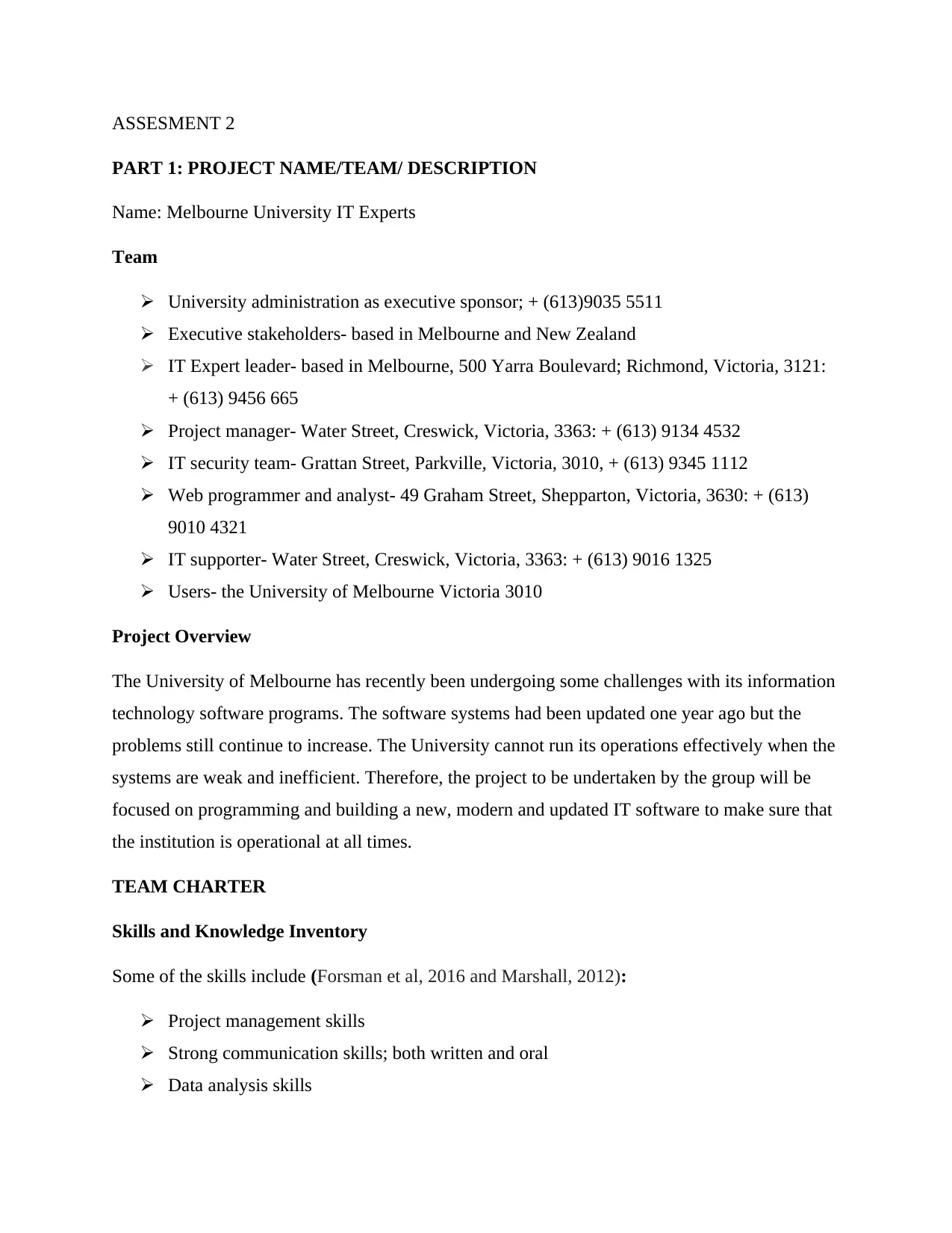
ASSESMENT 2
PART 1: PROJECT NAME/TEAM/ DESCRIPTION
Name: Melbourne University IT Experts
Team
University administration as executive sponsor; + (613)9035 5511
Executive stakeholders- based in Melbourne and New Zealand
IT Expert leader- based in Melbourne, 500 Yarra Boulevard; Richmond, Victoria, 3121:
+ (613) 9456 665
Project manager- Water Street, Creswick, Victoria, 3363: + (613) 9134 4532
IT security team- Grattan Street, Parkville, Victoria, 3010, + (613) 9345 1112
Web programmer and analyst- 49 Graham Street, Shepparton, Victoria, 3630: + (613)
9010 4321
IT supporter- Water Street, Creswick, Victoria, 3363: + (613) 9016 1325
Users- the University of Melbourne Victoria 3010
Project Overview
The University of Melbourne has recently been undergoing some challenges with its information
technology software programs. The software systems had been updated one year ago but the
problems still continue to increase. The University cannot run its operations effectively when the
systems are weak and inefficient. Therefore, the project to be undertaken by the group will be
focused on programming and building a new, modern and updated IT software to make sure that
the institution is operational at all times.
TEAM CHARTER
Skills and Knowledge Inventory
Some of the skills include (Forsman et al, 2016 and Marshall, 2012):
Project management skills
Strong communication skills; both written and oral
Data analysis skills
PART 1: PROJECT NAME/TEAM/ DESCRIPTION
Name: Melbourne University IT Experts
Team
University administration as executive sponsor; + (613)9035 5511
Executive stakeholders- based in Melbourne and New Zealand
IT Expert leader- based in Melbourne, 500 Yarra Boulevard; Richmond, Victoria, 3121:
+ (613) 9456 665
Project manager- Water Street, Creswick, Victoria, 3363: + (613) 9134 4532
IT security team- Grattan Street, Parkville, Victoria, 3010, + (613) 9345 1112
Web programmer and analyst- 49 Graham Street, Shepparton, Victoria, 3630: + (613)
9010 4321
IT supporter- Water Street, Creswick, Victoria, 3363: + (613) 9016 1325
Users- the University of Melbourne Victoria 3010
Project Overview
The University of Melbourne has recently been undergoing some challenges with its information
technology software programs. The software systems had been updated one year ago but the
problems still continue to increase. The University cannot run its operations effectively when the
systems are weak and inefficient. Therefore, the project to be undertaken by the group will be
focused on programming and building a new, modern and updated IT software to make sure that
the institution is operational at all times.
TEAM CHARTER
Skills and Knowledge Inventory
Some of the skills include (Forsman et al, 2016 and Marshall, 2012):
Project management skills
Strong communication skills; both written and oral
Data analysis skills
Secure Best Marks with AI Grader
Need help grading? Try our AI Grader for instant feedback on your assignments.
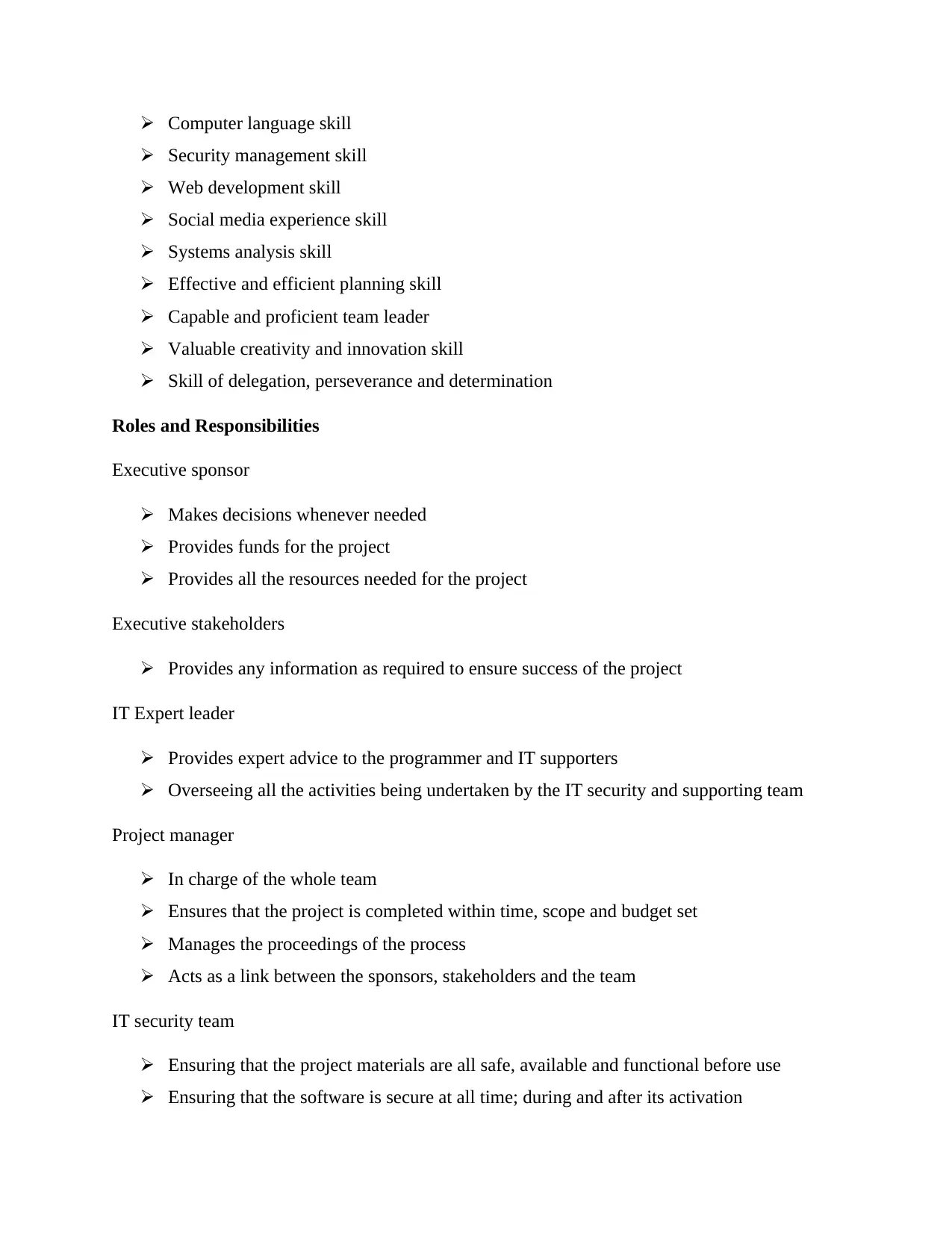
Computer language skill
Security management skill
Web development skill
Social media experience skill
Systems analysis skill
Effective and efficient planning skill
Capable and proficient team leader
Valuable creativity and innovation skill
Skill of delegation, perseverance and determination
Roles and Responsibilities
Executive sponsor
Makes decisions whenever needed
Provides funds for the project
Provides all the resources needed for the project
Executive stakeholders
Provides any information as required to ensure success of the project
IT Expert leader
Provides expert advice to the programmer and IT supporters
Overseeing all the activities being undertaken by the IT security and supporting team
Project manager
In charge of the whole team
Ensures that the project is completed within time, scope and budget set
Manages the proceedings of the process
Acts as a link between the sponsors, stakeholders and the team
IT security team
Ensuring that the project materials are all safe, available and functional before use
Ensuring that the software is secure at all time; during and after its activation
Security management skill
Web development skill
Social media experience skill
Systems analysis skill
Effective and efficient planning skill
Capable and proficient team leader
Valuable creativity and innovation skill
Skill of delegation, perseverance and determination
Roles and Responsibilities
Executive sponsor
Makes decisions whenever needed
Provides funds for the project
Provides all the resources needed for the project
Executive stakeholders
Provides any information as required to ensure success of the project
IT Expert leader
Provides expert advice to the programmer and IT supporters
Overseeing all the activities being undertaken by the IT security and supporting team
Project manager
In charge of the whole team
Ensures that the project is completed within time, scope and budget set
Manages the proceedings of the process
Acts as a link between the sponsors, stakeholders and the team
IT security team
Ensuring that the project materials are all safe, available and functional before use
Ensuring that the software is secure at all time; during and after its activation
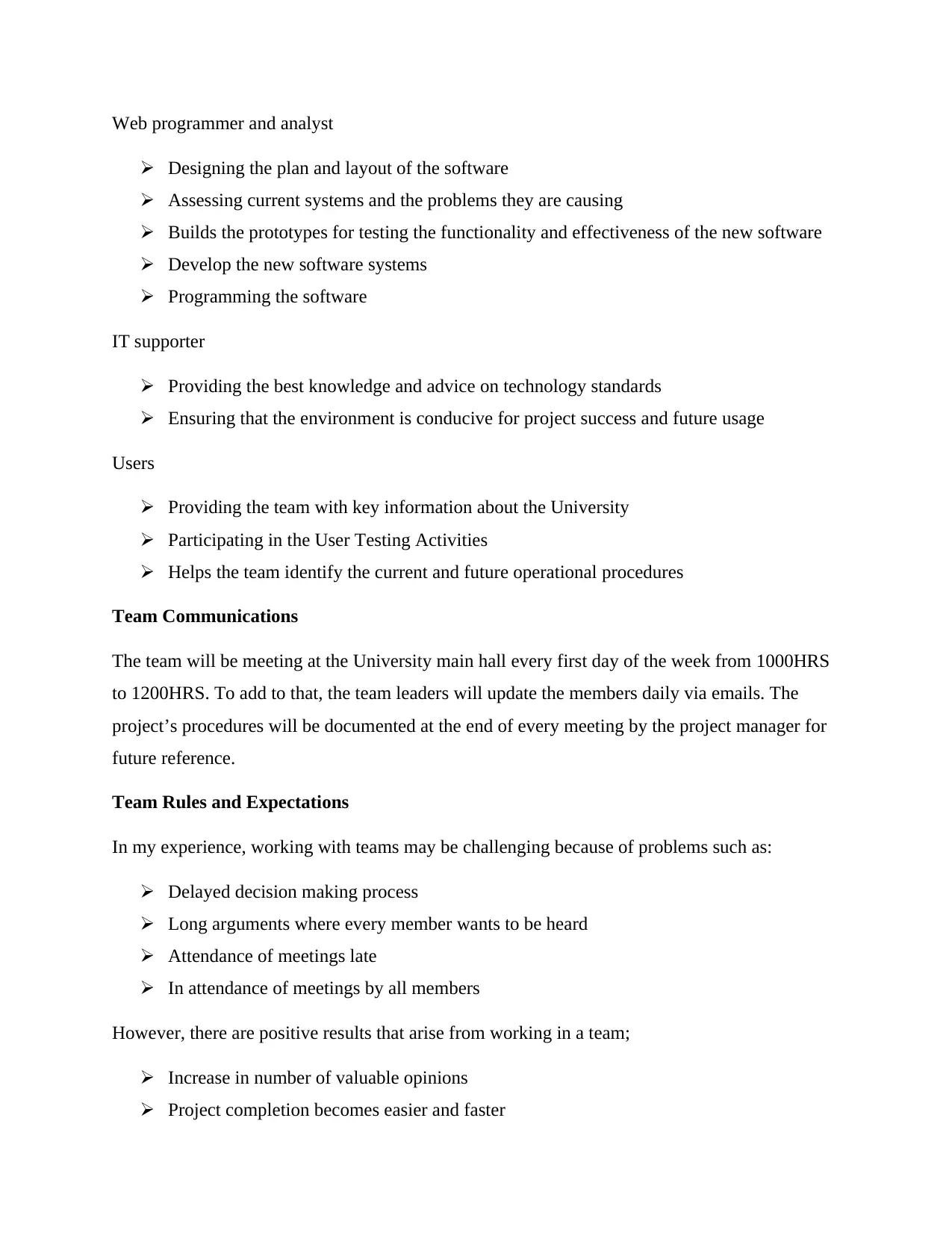
Web programmer and analyst
Designing the plan and layout of the software
Assessing current systems and the problems they are causing
Builds the prototypes for testing the functionality and effectiveness of the new software
Develop the new software systems
Programming the software
IT supporter
Providing the best knowledge and advice on technology standards
Ensuring that the environment is conducive for project success and future usage
Users
Providing the team with key information about the University
Participating in the User Testing Activities
Helps the team identify the current and future operational procedures
Team Communications
The team will be meeting at the University main hall every first day of the week from 1000HRS
to 1200HRS. To add to that, the team leaders will update the members daily via emails. The
project’s procedures will be documented at the end of every meeting by the project manager for
future reference.
Team Rules and Expectations
In my experience, working with teams may be challenging because of problems such as:
Delayed decision making process
Long arguments where every member wants to be heard
Attendance of meetings late
In attendance of meetings by all members
However, there are positive results that arise from working in a team;
Increase in number of valuable opinions
Project completion becomes easier and faster
Designing the plan and layout of the software
Assessing current systems and the problems they are causing
Builds the prototypes for testing the functionality and effectiveness of the new software
Develop the new software systems
Programming the software
IT supporter
Providing the best knowledge and advice on technology standards
Ensuring that the environment is conducive for project success and future usage
Users
Providing the team with key information about the University
Participating in the User Testing Activities
Helps the team identify the current and future operational procedures
Team Communications
The team will be meeting at the University main hall every first day of the week from 1000HRS
to 1200HRS. To add to that, the team leaders will update the members daily via emails. The
project’s procedures will be documented at the end of every meeting by the project manager for
future reference.
Team Rules and Expectations
In my experience, working with teams may be challenging because of problems such as:
Delayed decision making process
Long arguments where every member wants to be heard
Attendance of meetings late
In attendance of meetings by all members
However, there are positive results that arise from working in a team;
Increase in number of valuable opinions
Project completion becomes easier and faster
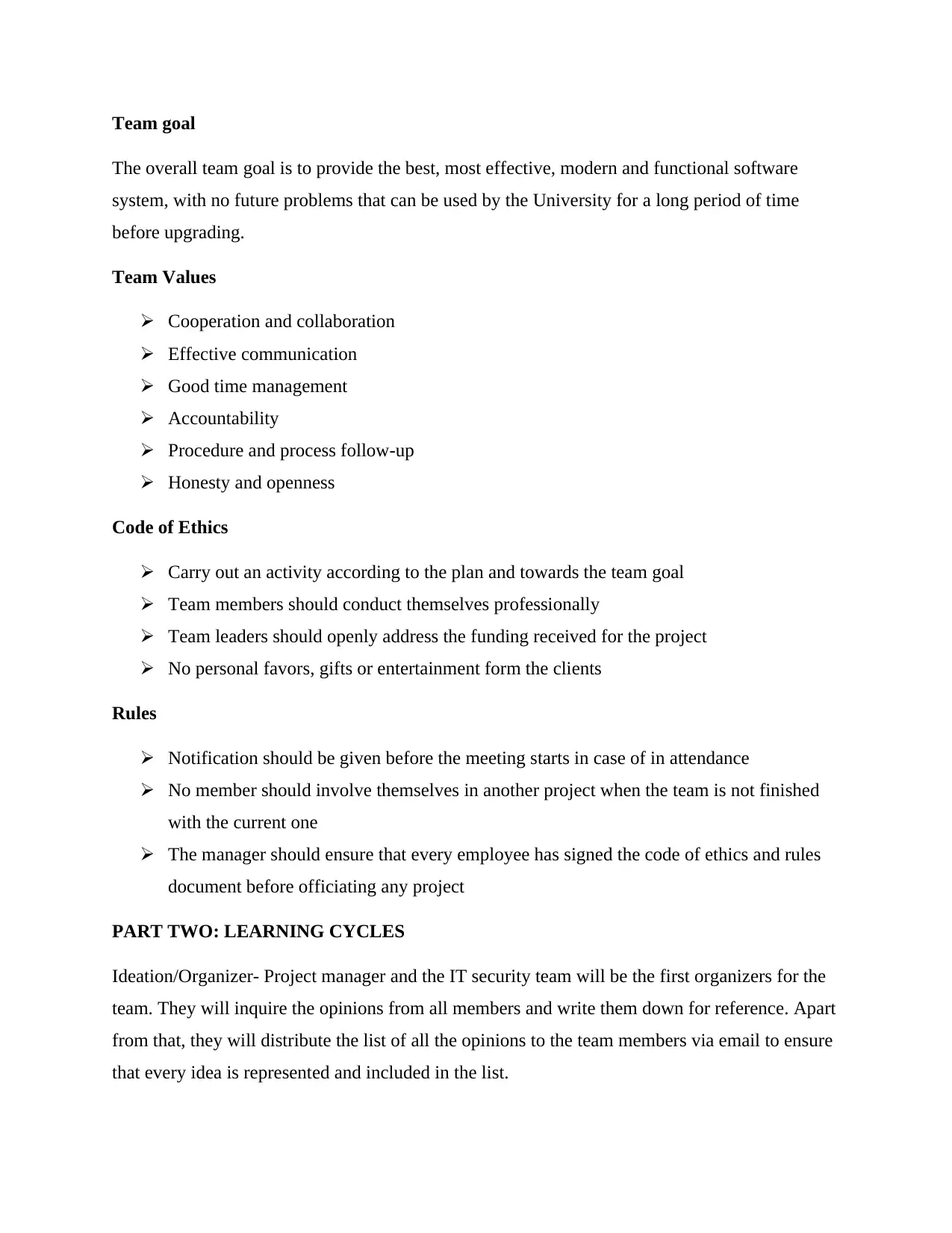
Team goal
The overall team goal is to provide the best, most effective, modern and functional software
system, with no future problems that can be used by the University for a long period of time
before upgrading.
Team Values
Cooperation and collaboration
Effective communication
Good time management
Accountability
Procedure and process follow-up
Honesty and openness
Code of Ethics
Carry out an activity according to the plan and towards the team goal
Team members should conduct themselves professionally
Team leaders should openly address the funding received for the project
No personal favors, gifts or entertainment form the clients
Rules
Notification should be given before the meeting starts in case of in attendance
No member should involve themselves in another project when the team is not finished
with the current one
The manager should ensure that every employee has signed the code of ethics and rules
document before officiating any project
PART TWO: LEARNING CYCLES
Ideation/Organizer- Project manager and the IT security team will be the first organizers for the
team. They will inquire the opinions from all members and write them down for reference. Apart
from that, they will distribute the list of all the opinions to the team members via email to ensure
that every idea is represented and included in the list.
The overall team goal is to provide the best, most effective, modern and functional software
system, with no future problems that can be used by the University for a long period of time
before upgrading.
Team Values
Cooperation and collaboration
Effective communication
Good time management
Accountability
Procedure and process follow-up
Honesty and openness
Code of Ethics
Carry out an activity according to the plan and towards the team goal
Team members should conduct themselves professionally
Team leaders should openly address the funding received for the project
No personal favors, gifts or entertainment form the clients
Rules
Notification should be given before the meeting starts in case of in attendance
No member should involve themselves in another project when the team is not finished
with the current one
The manager should ensure that every employee has signed the code of ethics and rules
document before officiating any project
PART TWO: LEARNING CYCLES
Ideation/Organizer- Project manager and the IT security team will be the first organizers for the
team. They will inquire the opinions from all members and write them down for reference. Apart
from that, they will distribute the list of all the opinions to the team members via email to ensure
that every idea is represented and included in the list.
Secure Best Marks with AI Grader
Need help grading? Try our AI Grader for instant feedback on your assignments.
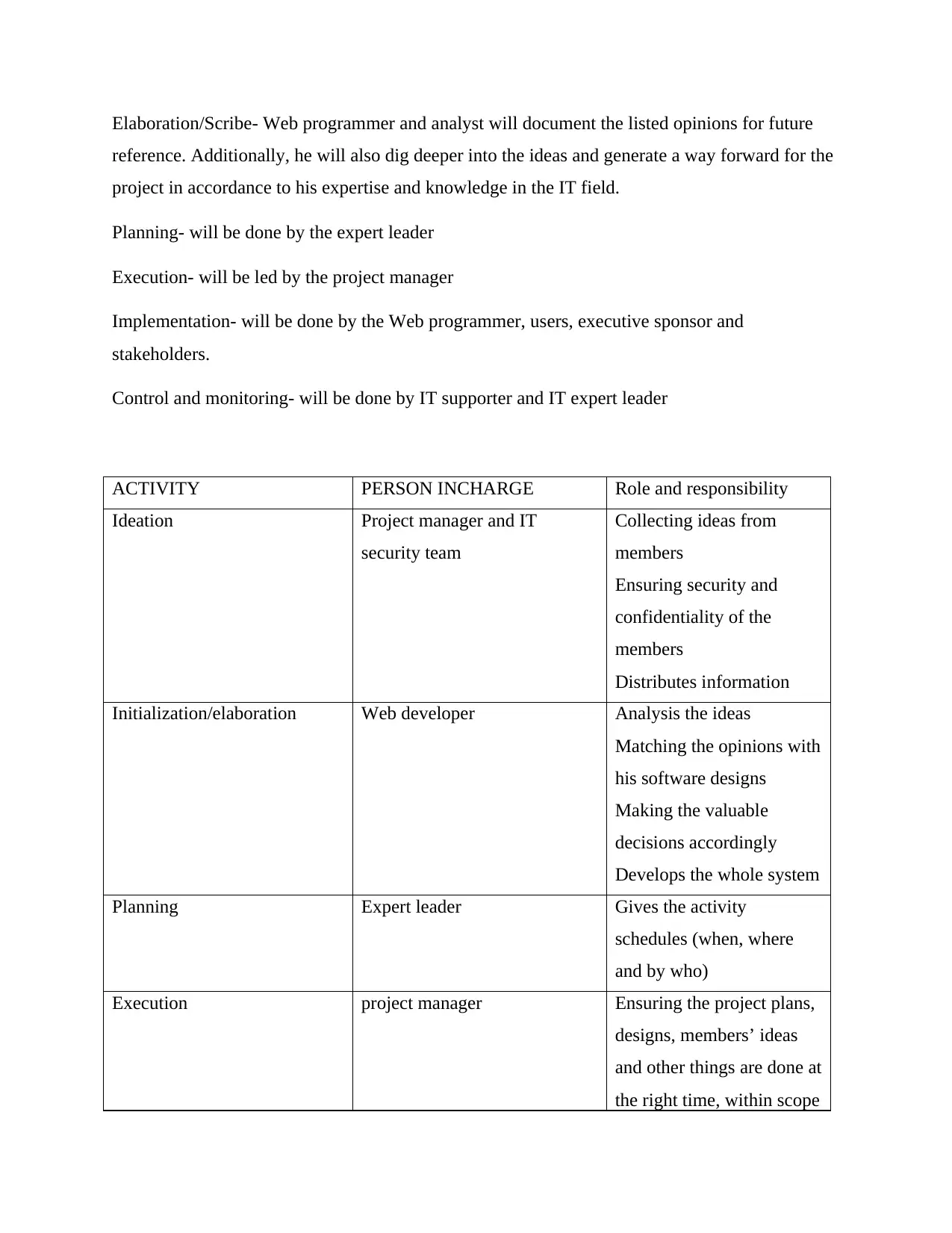
Elaboration/Scribe- Web programmer and analyst will document the listed opinions for future
reference. Additionally, he will also dig deeper into the ideas and generate a way forward for the
project in accordance to his expertise and knowledge in the IT field.
Planning- will be done by the expert leader
Execution- will be led by the project manager
Implementation- will be done by the Web programmer, users, executive sponsor and
stakeholders.
Control and monitoring- will be done by IT supporter and IT expert leader
ACTIVITY PERSON INCHARGE Role and responsibility
Ideation Project manager and IT
security team
Collecting ideas from
members
Ensuring security and
confidentiality of the
members
Distributes information
Initialization/elaboration Web developer Analysis the ideas
Matching the opinions with
his software designs
Making the valuable
decisions accordingly
Develops the whole system
Planning Expert leader Gives the activity
schedules (when, where
and by who)
Execution project manager Ensuring the project plans,
designs, members’ ideas
and other things are done at
the right time, within scope
reference. Additionally, he will also dig deeper into the ideas and generate a way forward for the
project in accordance to his expertise and knowledge in the IT field.
Planning- will be done by the expert leader
Execution- will be led by the project manager
Implementation- will be done by the Web programmer, users, executive sponsor and
stakeholders.
Control and monitoring- will be done by IT supporter and IT expert leader
ACTIVITY PERSON INCHARGE Role and responsibility
Ideation Project manager and IT
security team
Collecting ideas from
members
Ensuring security and
confidentiality of the
members
Distributes information
Initialization/elaboration Web developer Analysis the ideas
Matching the opinions with
his software designs
Making the valuable
decisions accordingly
Develops the whole system
Planning Expert leader Gives the activity
schedules (when, where
and by who)
Execution project manager Ensuring the project plans,
designs, members’ ideas
and other things are done at
the right time, within scope
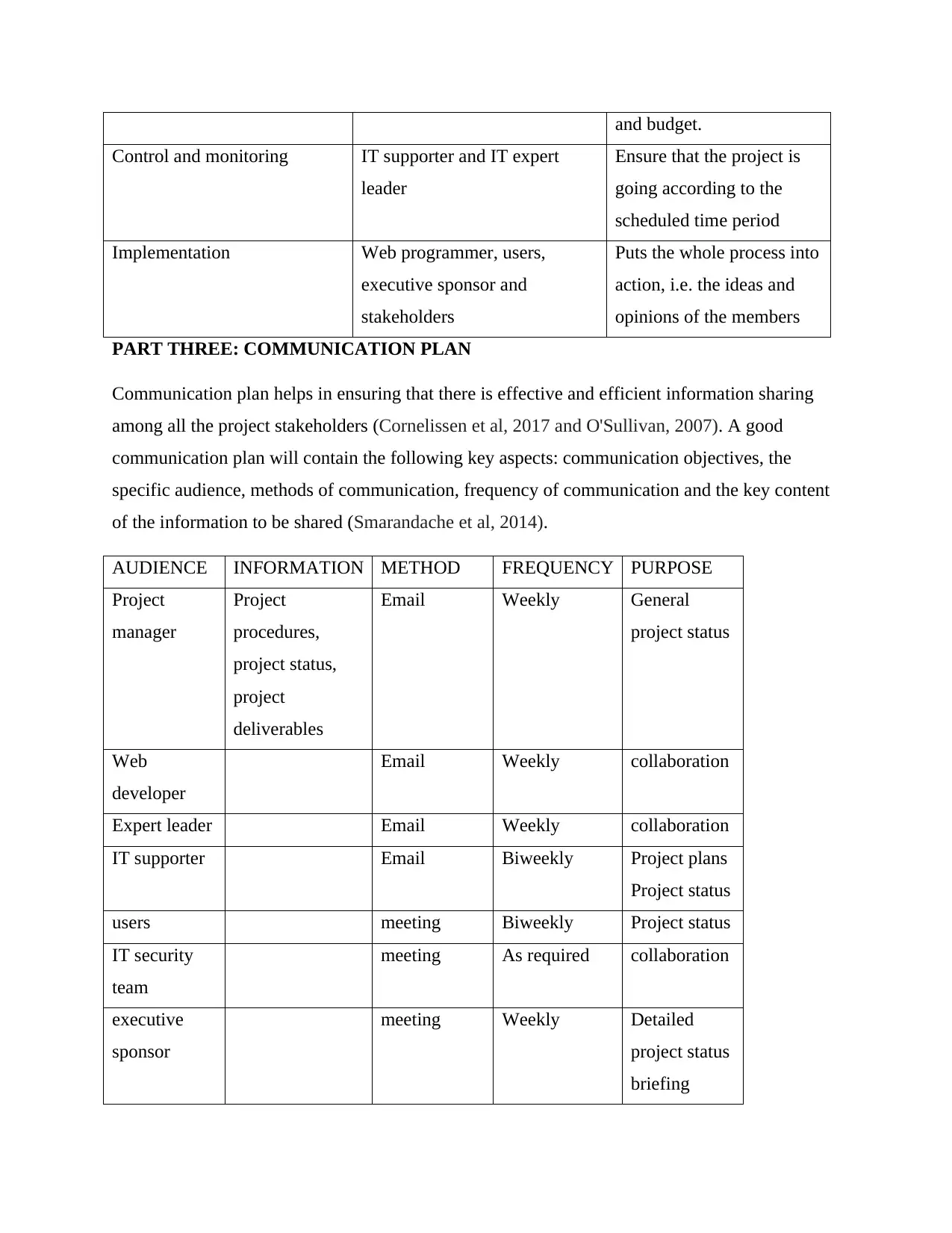
and budget.
Control and monitoring IT supporter and IT expert
leader
Ensure that the project is
going according to the
scheduled time period
Implementation Web programmer, users,
executive sponsor and
stakeholders
Puts the whole process into
action, i.e. the ideas and
opinions of the members
PART THREE: COMMUNICATION PLAN
Communication plan helps in ensuring that there is effective and efficient information sharing
among all the project stakeholders (Cornelissen et al, 2017 and O'Sullivan, 2007). A good
communication plan will contain the following key aspects: communication objectives, the
specific audience, methods of communication, frequency of communication and the key content
of the information to be shared (Smarandache et al, 2014).
AUDIENCE INFORMATION METHOD FREQUENCY PURPOSE
Project
manager
Project
procedures,
project status,
project
deliverables
Email Weekly General
project status
Web
developer
Email Weekly collaboration
Expert leader Email Weekly collaboration
IT supporter Email Biweekly Project plans
Project status
users meeting Biweekly Project status
IT security
team
meeting As required collaboration
executive
sponsor
meeting Weekly Detailed
project status
briefing
Control and monitoring IT supporter and IT expert
leader
Ensure that the project is
going according to the
scheduled time period
Implementation Web programmer, users,
executive sponsor and
stakeholders
Puts the whole process into
action, i.e. the ideas and
opinions of the members
PART THREE: COMMUNICATION PLAN
Communication plan helps in ensuring that there is effective and efficient information sharing
among all the project stakeholders (Cornelissen et al, 2017 and O'Sullivan, 2007). A good
communication plan will contain the following key aspects: communication objectives, the
specific audience, methods of communication, frequency of communication and the key content
of the information to be shared (Smarandache et al, 2014).
AUDIENCE INFORMATION METHOD FREQUENCY PURPOSE
Project
manager
Project
procedures,
project status,
project
deliverables
Email Weekly General
project status
Web
developer
Email Weekly collaboration
Expert leader Email Weekly collaboration
IT supporter Email Biweekly Project plans
Project status
users meeting Biweekly Project status
IT security
team
meeting As required collaboration
executive
sponsor
meeting Weekly Detailed
project status
briefing
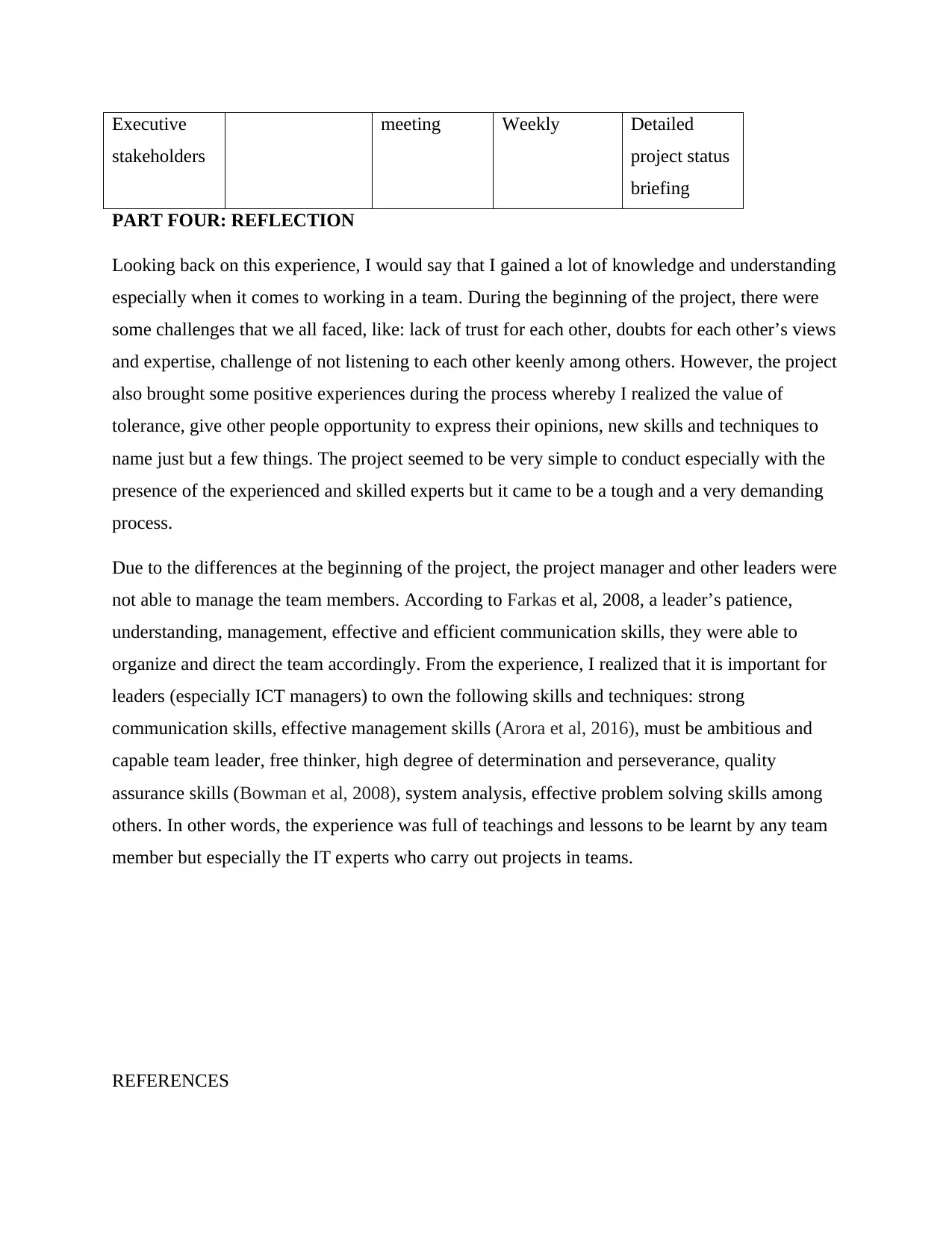
Executive
stakeholders
meeting Weekly Detailed
project status
briefing
PART FOUR: REFLECTION
Looking back on this experience, I would say that I gained a lot of knowledge and understanding
especially when it comes to working in a team. During the beginning of the project, there were
some challenges that we all faced, like: lack of trust for each other, doubts for each other’s views
and expertise, challenge of not listening to each other keenly among others. However, the project
also brought some positive experiences during the process whereby I realized the value of
tolerance, give other people opportunity to express their opinions, new skills and techniques to
name just but a few things. The project seemed to be very simple to conduct especially with the
presence of the experienced and skilled experts but it came to be a tough and a very demanding
process.
Due to the differences at the beginning of the project, the project manager and other leaders were
not able to manage the team members. According to Farkas et al, 2008, a leader’s patience,
understanding, management, effective and efficient communication skills, they were able to
organize and direct the team accordingly. From the experience, I realized that it is important for
leaders (especially ICT managers) to own the following skills and techniques: strong
communication skills, effective management skills (Arora et al, 2016), must be ambitious and
capable team leader, free thinker, high degree of determination and perseverance, quality
assurance skills (Bowman et al, 2008), system analysis, effective problem solving skills among
others. In other words, the experience was full of teachings and lessons to be learnt by any team
member but especially the IT experts who carry out projects in teams.
REFERENCES
stakeholders
meeting Weekly Detailed
project status
briefing
PART FOUR: REFLECTION
Looking back on this experience, I would say that I gained a lot of knowledge and understanding
especially when it comes to working in a team. During the beginning of the project, there were
some challenges that we all faced, like: lack of trust for each other, doubts for each other’s views
and expertise, challenge of not listening to each other keenly among others. However, the project
also brought some positive experiences during the process whereby I realized the value of
tolerance, give other people opportunity to express their opinions, new skills and techniques to
name just but a few things. The project seemed to be very simple to conduct especially with the
presence of the experienced and skilled experts but it came to be a tough and a very demanding
process.
Due to the differences at the beginning of the project, the project manager and other leaders were
not able to manage the team members. According to Farkas et al, 2008, a leader’s patience,
understanding, management, effective and efficient communication skills, they were able to
organize and direct the team accordingly. From the experience, I realized that it is important for
leaders (especially ICT managers) to own the following skills and techniques: strong
communication skills, effective management skills (Arora et al, 2016), must be ambitious and
capable team leader, free thinker, high degree of determination and perseverance, quality
assurance skills (Bowman et al, 2008), system analysis, effective problem solving skills among
others. In other words, the experience was full of teachings and lessons to be learnt by any team
member but especially the IT experts who carry out projects in teams.
REFERENCES
Paraphrase This Document
Need a fresh take? Get an instant paraphrase of this document with our AI Paraphraser

Arora, S., & Darzi, A. (2016). Introducing Technical Skills Assessment Into Certification:
Closing the Implementation Gap. Annals of surgery, 264(1), 7-9.
Bowman, J., & Wilson, J. P. (2008). Different roles, different perspectives: perceptions about the
purpose of training needs analysis. Industrial and Commercial Training, 40(1), 38-41.
Cornelissen, J., & Cornelissen, J. P. (2017). Corporate communication: A guide to theory and
practice. Sage.
Farkas, A., & Nagy, V. (2008). Student assessment of desirable technical skills: a
correspondence analysis approach. Acta Polytechnica Hungarica, 5(2), 43-57.
Forsman, H., Gråstén, A., Blomqvist, M., Davids, K., Liukkonen, J., & Konttinen, N. (2016).
Development of perceived competence, tactical skills, motivation, technical skills, and
speed and agility in young soccer players. Journal of sports sciences, 34(14), 1311-1318.
Marshall, M. B. (2012). Simulation for technical skills.
O'Sullivan, K. J. (2007). Creating and executing an internal communications plan for knowledge
management systems deployments. Journal of Knowledge Management, 11(2), 102-108.
Smarandache, F., & Vladutescu, S. (2014). Towards a Practical Communication
Intervention. Revista de Cercetare si Interventie Sociala, 46, 243.
Closing the Implementation Gap. Annals of surgery, 264(1), 7-9.
Bowman, J., & Wilson, J. P. (2008). Different roles, different perspectives: perceptions about the
purpose of training needs analysis. Industrial and Commercial Training, 40(1), 38-41.
Cornelissen, J., & Cornelissen, J. P. (2017). Corporate communication: A guide to theory and
practice. Sage.
Farkas, A., & Nagy, V. (2008). Student assessment of desirable technical skills: a
correspondence analysis approach. Acta Polytechnica Hungarica, 5(2), 43-57.
Forsman, H., Gråstén, A., Blomqvist, M., Davids, K., Liukkonen, J., & Konttinen, N. (2016).
Development of perceived competence, tactical skills, motivation, technical skills, and
speed and agility in young soccer players. Journal of sports sciences, 34(14), 1311-1318.
Marshall, M. B. (2012). Simulation for technical skills.
O'Sullivan, K. J. (2007). Creating and executing an internal communications plan for knowledge
management systems deployments. Journal of Knowledge Management, 11(2), 102-108.
Smarandache, F., & Vladutescu, S. (2014). Towards a Practical Communication
Intervention. Revista de Cercetare si Interventie Sociala, 46, 243.
1 out of 8
Related Documents
Your All-in-One AI-Powered Toolkit for Academic Success.
+13062052269
info@desklib.com
Available 24*7 on WhatsApp / Email
![[object Object]](/_next/static/media/star-bottom.7253800d.svg)
Unlock your academic potential
© 2024 | Zucol Services PVT LTD | All rights reserved.





